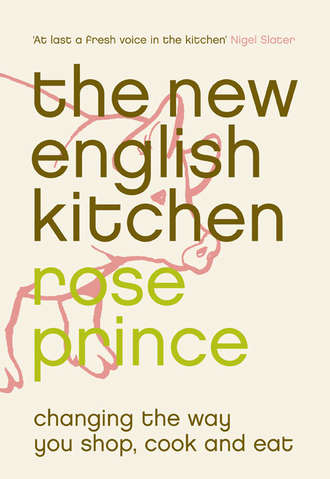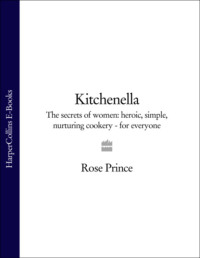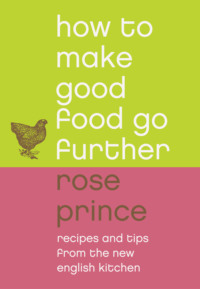
Полная версия
The New English Kitchen: Changing the Way You Shop, Cook and Eat
sourdough bread, wine and onion soup
This is much, much nicer than French onion soup. Instead of one large croûton with cheese in each bowl, the bread is layered, club-sandwich style, with the cheese and baked separately. The hot soup is then ladled over the top.
Serves 4
5 tablespoons olive oil
1.4kg/3lb pink or white onions, sliced
a large pinch of dried thyme
175 ml/6 fl oz red wine
1.2 litres/2 pints well-flavoured beef stock
4 large slices of sourdough bread
1 garlic clove, lightly crushed but left whole
4 heaped tablespoons grated hard cheese (see Kitchen
Note overleaf)
salt and freshly ground black pepper
Heat 3 tablespoons of the oil in a large pan and add the onions, thyme and some salt. Cook over a very, very low heat for about 45 minutes, until pale gold, soft and sweet tasting. Add the wine, deglazing or scraping any cooking bits from the base of the pan with a wooden spatula. Add the beef stock and bring to simmering point. Taste for seasoning and add salt if necessary. Grind over a little black pepper.
Preheat the oven to 190°C/375°F/Gas Mark 5. Rub each slice of bread with the garlic, brush with the remaining oil and cut into quarters. Place 4 pieces of bread in a baking dish. Spoon a dessertspoonful of the cooked onions on to each, followed by a teaspoon of grated cheese, then place another piece of bread on top and repeat, continuing until you have used up all the bread and have 4 multi-layered croûtons. Bake them in the oven for about 15 minutes, until the tops are golden and bubbling.
Put a croûton in each serving bowl. Bring the soup back to boiling point if you have set it to one side. Ladle the onion broth over the croûtons and serve immediately.
kitchen note
I recommend using a hard sheep’s milk, Pecorino-style cheese, such as Lord of the Hundreds or Somerset Rambler, for the croûtons. You could also use a traditional farmhouse Cheddar or other cow’s milk cheese, hard or crumbly. See here for information on cooking with British and Irish cheeses.
summer pudding
This moulded pudding made from dry white bread and a mixture of lightly stewed berries doesn’t require an exact recipe. You will need enough fruit to fill the pudding basin you wish to use, plus a little over. You could use a traditional pudding basin, a soufflé dish or any shallow dish. I sometimes make summer pudding in large plastic containers for children’s meals, serving helpings from them as and when needed. Raspberries, blackberries, tayberries, red and blackcurrants are all suitable for the filling – it’s best to use a mixture, but the pectin-rich raspberries are pretty much essential. You can use strawberries, but they tend to disintegrate wastefully when cooked.
Simply stew the fruit gently until the juices run and add enough sugar to remove any sourness. Line the pudding basin with slices of day-old white bread, pour in the compote and cover with a ‘lid’ of sliced bread, then a saucer small enough to fit inside the basin. Put a weight on top – a can of tomatoes will do – and leave in the fridge overnight.
Push any leftover compote through a sieve to make a sauce. To turn the pudding out, run a blunt knife between the bread casing and the bowl. Invert a plate on top and turn the basin and plate over. If you have ever got water in your gumboots, you will know the noise a summer pudding makes when it unmoulds. Pour over the sauce to cover any white patches. Serve with crème fraîche.
kitchen note
Frozen English berries, organic or conventionally farmed, are a wonderful source of winter fruit and, unlike exotic fruits, they are free of air freight and fossil fuel issues. I use them to make summer puddings in winter for school packed lunches or simply to cheer everyone up. I find them in supermarkets but also in farm shops in big chest freezers.
toffee pudding
Constance Spry again, with a pudding whose flavour has only to be tasted to be loved. I have fed this to everyone and, despite its obvious fudgy stickiness and collapsed appearance, they all say how light it is. Recipe trickery at its best.
Serves 4
120g/4oz butter
120g/4oz demerara sugar
240g/8oz golden syrup
300ml/1/2 pint milk
4 thick slices of bread, crusts removed, cut into fingers
whipped cream, to serve
Heat the butter, sugar and golden syrup in a small pan and boil for 3 minutes. Remove from the heat and keep warm. In a separate pan, heat the milk to boiling point. Put the fingers of bread in a dish and pour over the milk. Lift them out, put them into 4 serving bowls and pour over the sauce – you can dip them in the sauce instead but you will have to work fast. Serve immediately, with whipped cream.
winter charlotte with rhubarb and raspberries
For charlottes, buttered day-old bread is placed on top of the fruit and the pudding is baked. Apples and berries make good charlottes, and it is even possible to make a savoury charlotte with chicory, apple and spices that have been slowly cooked until sweet.
Here is a baked winter version of summer pudding, filled with forced rhubarb and frozen raspberries.
Serves 6
about 8 slices of day-old white bread, crusts removed (reserve
them for breadcrumbs, if you like – see here)
softened unsalted butter
ground cinnamon
700g/11/2lb forced rhubarb, cut into 2cm/3/4 inch lengths
(see here)
400g/14oz frozen raspberries
golden caster sugar
Preheat the oven to 200°C/400°F/Gas Mark 6. Butter the bread slices and sprinkle with a little cinnamon. Cut each slice into quarters, then into 8 small triangles.
Put the rhubarb and raspberries into a pan, cover and cook over a low heat until the rhubarb is just soft. Add enough sugar to sweeten to your taste, then pour into a shallow ovenproof dish. Arrange the triangles of bread on top, buttered-side up, working in a fish-scale pattern. Bake the charlotte for about half an hour, until the surface of the bread is golden brown. Remove from the oven and sprinkle caster sugar on top. Serve with fresh custard (see here) or thick double cream.
brioche and fig pudding
For the last 15 years it has been easy to buy French-style breads in almost every town. Purists will quibble at their quality, but they have the slight sourness, crust and tearable dough that make French breads so wonderful. Next to arrive has been brioche – and no, it’s not as good as the artisan-style buttery bread whose fragrance pours out of pâtisseries across the Channel, but it’s not bad either. Our local late-night shop always sells brioche loaves wrapped in plastic, which keep for a suspiciously long time. They are too claggy to eat fresh but make terrific emergency puddings.
Serves 4
10 slices of brioche
5 ready-to-eat dried figs, sliced
4 egg yolks
300ml/1/2 pint whole milk
125ml/4fl oz double cream
1 tablespoon golden caster sugar
1/2 teaspoon vanilla extract
a pinch of grated nutmeg
caster sugar for dusting
Preheat the oven to 190°C/375°F/Gas Mark 5. Toast the brioche slices in a dry frying pan over a medium heat; they burn very easily, so be careful. Cut the slices into triangles and arrange them in overlapping layers in an ovenproof dish, points/corners up. Slot a slice of fig between each one.
Whisk the egg yolks into the milk and add the cream, sugar and vanilla. Put in a saucepan and heat gently, stirring, but do not let it boil. As soon as it thickens slightly, pour it over the brioche and figs and scatter a pinch of nutmeg on to the surface. Bake the pudding for 20–30 minutes, until golden on top and just set. Dust with caster sugar and serve with cream.
alternative flours
Flour made from wheat is clearly the most versatile, and the keeping qualities gluten gives to bread are a real advantage, as the previous recipes show. But there are alternative flours made from vegetables and nuts that are well worth discovering. Finding a bag of gram flour in an Asian shop in Tooting Bec was the beginning of a new friendship with flour in savoury cooking for me, and my favourite recipe for orange cake would be no good without potato flour.
gram flour
Gram flour is milled from dried chick peas and is a light, gentle-flavoured flour with a smooth texture. It is used extensively in Indian cooking, in fritters or to coat vegetables for frying.
gram coating for poultry, game and fish
A practical way to season poultry and game or whole fish like sole and trout before you fry it. Quicker than breadcrumbing, it also absorbs the sometimes unpleasant fat on poultry skin that spits as it cooks.
gram flour
1 teaspoon salt
2 teaspoons dried oregano
freshly ground black pepper
Scatter gram flour on to a dinner plate in a layer 5 mm/1/4 inch deep. Mix in the salt and oregano and grind over some black pepper. Roll the meat or fish in the mixture and cook.
gram and cheddar shortbreads
Makes 12–16 (enough to serve 4 people with drinks)
90g/3oz gram flour, sifted
75g/21/2oz very mature farmhouse Cheddar cheese, roughly grated
75g/21/2oz chilled unsalted butter, cut into cubes
a large pinch of cayenne pepper
1/2 teaspoon sea salt
a pinch of freshly ground black pepper
1 tablespoon very cold water
Preheat the oven to 190°C/375°F/Gas Mark 5. Put the flour, cheese, butter, cayenne and seasoning into a food processor and whiz until the mixture has a breadcrumb consistency. Add the water and whiz again. As soon as the crumbs begin to form a dough, tip them on to a board and knead together until smooth. Work quickly; the mixture should not become greasy.
Shape the dough into a cylinder and cut it into 1cm thick slices. Put them 2cm/3/4 inch apart on a baking sheet lined with baking parchment or greaseproof paper. Place in the fridge for 20 minutes, then bake for 15 minutes, until the shortbreads are slightly puffed, their edges lightly brown.
kitchen note
To decorate and add flavour, roll the cylinder of dough in chopped pistachio nuts, or scatter toasted black cumin seeds or flaked almonds on to the sliced biscuits before baking.
potato flour
In Italy, potato flour is added to sweet cakes with ground nuts, giving them an almost impossible lightness and delicious dry crumb. It is also used to coat pork before frying. Also known as fécule, potato flour is available from Italian stores and wholefood shops. It is very white, and squeaks when rubbed between your fingers.
almond and orange cake
Based on Anna del Conte’s recipe in her book, Secrets of an Italian Kitchen (Bantam Press, 1989), this is a subtle cake to eat after a meal with a little crème fraîche.
150g/5oz blanched almonds, whole or flaked
3 eggs, separated
150g/5oz golden caster sugar
60g/2oz potato flour
11/2 oranges
a pinch of salt
30g/1oz butter, softened
icing sugar for dusting
Preheat the oven to 160°C/325°F/Gas Mark 3. Chop the almonds in a food processor, or finely by hand, until they have a crumb-like texture. Whisk the egg yolks with the sugar until pale and creamy. Add the almonds and the potato flour. Grate the zest of the whole orange into the mixture, then add the juice of 11/2 oranges.
In a separate bowl, whisk the egg whites with the salt until they form stiff peaks. Fold them into the orange and egg mixture. Butter a 20cm/8 inch round cake tin – use up all the butter; when it cooks it will be absorbed into the cake and form a delicious crust. Pour in the mixture and bake for 50 minutes, until the cake has shrunk from the side of the tin and feels springy when you press the surface with a finger. Unmould the cake and cool on a wire rack. Dust with icing sugar.
2 store
A good cook knows how to squirrel food away, storing it to save not just time but money, too. Squirrelling reduces the number of occasions when you hear yourself say, ‘I haven’t the time to cook.’ It is also a comfort when you don’t want to shop. It’s not that taking an evening off cooking is a bad thing, but with the pressure upon everyone to work longer hours and spend more time on other pursuits, a night off cooking can turn into six nights. And unless you really hate cooking, it’s not just the cost that is irksome but the sensation that you are 100 per cent reliant on others to choose the food you eat.
A good store of food not only means more home cooking and therefore more pleasure, it makes good economic sense, rewarding you with more money to spend on other things.
A few organisational skills are needed. Briefly imagine living on a boat. The bulk of what you eat must come from packets, cans, or sacks kept in the dark to prevent the contents rotting. Before the days of fridge freezers, the ship’s cook must have been a man of talent, able not only to improvise with the few fresh ingredients available but – who knows? – perhaps also to prevent a crew going stir-crazy from meal tedium. Knowing how to use your stores is a good discipline. Even with the advantages of refrigerated storage, store food has changed little from centuries ago.
The miles of aisles devoted to bottled, canned, frozen and packet food are endless. Spoilt for choice, that’s us – yet look again and there are very few things that anyone really needs. Cooking sauce? Try a little oil, spice and lemon. Flavoured rice? Add dried wild mushrooms to ordinary rice. Ready-made vegetable curry? Heat canned tomatoes, coconut milk and spices with canned chick peas.
Food manufacturers are always keen to show journalists their latest innovations. Warrens of laboratories are devoted to the imaginings of their development teams. In the name of convenience, they bottle and preserve our favourite foods and create some weird new ones. My heart sinks when I see all this effort in pursuit of the impossible. Fresh pesto tickles every sense; bottled is, well, all right. Home-made tomato sauce is sweet, light and delicate; commercially bottled tomato sauce is salty and acidic, bulked out with thickeners to make money for the manufacturer. None of these is essential. Lazy cooks could save themselves the bother of carrying it all home if only they would shake a little good olive oil on to cooked pasta, chop a bit of chilli and mash a little garlic. This is olio d’aglio – the sauce to make when you come in at midnight, desperate not just for food but for real cooking.
The contents of my store cupboard are minimal. Actually, that’s not entirely true. The contents of my store cupboard are vast, but most of it is food bought that is never finished. No matter how clever the manufacturer, I don’t want their poppy seed, tarragon and lemon salad dressing – I want my bottle of olive oil and a lemon, and a little soft crystal sea salt. The contents of my store cupboard that I use are minimal. That is the truth.
This is about the sum of it. I could potentially survive on the following but the children would complain:
dried foods







the fridge



the freezer





The dried foods listed above are items that have, more or less, been in store cupboards for ever. The important thing is to put them into a modern context, making them fit the life you lead now. It isn’t necessary to buy 50 different foods a week. Just a few will do, each put to more than one use. Look at what is fresh in the house, or what can be bought at the shop you pass on the way home. Can it be used with one of your store foods? The shop has spring onions, you have some eggs, frozen peas, and cooked rice left over from last night. A bowl of fried rice is yours, and very good it can be.
cooked store foods
There is a group of storable foods that, since they are already cooked, can be swiftly added to something else for an almost-instant meal. Leftover rice; tomatoes simmered until sweet with oil; mashed potato; braised lentils; meat sauce, and stock – these are the things that really do save time shopping and cooking, while simultaneously helping to provide the home cooking that everyone craves deep down.
food-safety rules
Modern food-safety advice can be the enemy of good home economics. It encourages wastefulness and, worse, it promotes the idea of microwaving chilled or frozen food in sealed containers. Talk of reheating food is viewed by the food-safety authorities as subversive stuff – dangerous talk perverting the nanny state’s plan to make all food safe. But there’s no hope of making all food safe. Not when 60 million humans are on the loose – eating dirt as babies, sharing dinners with family pets as toddlers. Who hasn’t occasionally sampled the glory of a dropped 99 ice cream with its topping of earth and grass, or gallantly rescued a dusty boiled sweet from under the sofa? And in adulthood there are all sorts of opportunities to eat living food, as you begin to enjoy handmade cheeses, air-dried meat and reheated leftovers.
The thing to bear in mind is that the most dangerous thing about food is the person handling it. If you store and reheat food, use your common sense, and your senses. Keep cooked food in clean, sealed containers in the fridge and check it for signs of deterioration in terms of appearance and smell. Always make sure you reheat food thoroughly before use, and the risk to anyone who’s had that dirt-eating, droppedlolly childhood should be low.
rice
I recommend deliberately cooking more long grain or basmati rice than you need. Kept in a sealed container in the fridge, it yields almost-instant meals throughout the week: reheated into a pilaff with meat or vegetables; stir-fried with peas; or stirred into lemongrass-infused coconut milk. Short grain or risotto rice can be partly cooked, then stored to make into quick risottos; any leftover risotto can be rolled into balls, crumbed, fried and eaten with green salad.
rice economics
The value of rice – and all grains, beans and pulses, for that matter – lies in its ability to provide a cheap, meatless meal. Once you accept the principle that more must be paid for better meat, inexpensive foods such as rice become essential. A kilo of good-quality basmati rice should cost around £2.75, while Arborio rice will be about £4. They will yield 20 servings of 50g, each serving costing 14 pence and 20 pence respectively. The cost of added fat, vegetables, herbs and spices is minimal, so this is great food, economically and gastronomically.
buying rice
To make it easy, I buy just two types of rice: genuine long grain basmati from India or Pakistan, and Italian short grain rice, usually Arborio but I have also made short grain rice dishes with Carnaroli, Spanish paella rice and even ‘pudding rice’, which works magnificently in emergencies.
Basmati rice is grown in the foothills of the Himalayas, in both India and Pakistan. It is the rice I eat plain with curries and sometimes with fish, or make into pilaffs and re-fry in a pan. Good basmati lengthens to almost twice its size when cooked, so it is worth paying for the best. Choose genuine brands, labelled ‘pure’ basmati, rather than the cheaper, inferior hybrids, which do not lengthen in the same way.







